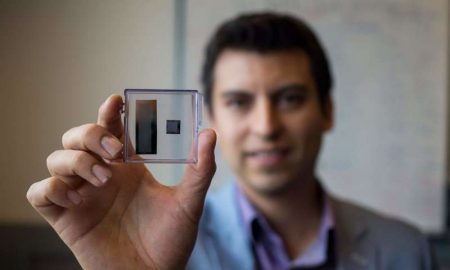September 22, 2018 – A band-aid sized wearable electronic device invented at the University of British Columbia (UBC) may make ultrasounds ubiquitous in imaging diagnostics even in the poorest countries on the planet. Engineers at the university have invented a portable, wearable scanner that replaces piezoelectric crystals used by conventional ultrasound equipment. Instead, the device is built from tiny vibrating drums constructed from polymer capacitive micro-machined ultrasound transducers, or polyCMUTS, a polymer resin containing silicon nitride, polysilicon, chromium, and aluminum in a thin wafer and costing less than $100 to make.
The ultrasound images this new device creates are sharper and more detailed than scanning equipment used in world hospitals and clinics today. And better yet, the low energy requirements, drawing only 10 volts to operate, means the scanner can be powered by a smartphone. The flexibility of the polymer material makes it possible to shape it in various ways so that it can be wrapped around a body to create much more detailed views.
Robert Rohling, Professor of Mechanical Engineering and Electrical Computer Engineering, at UBC, and one of the inventors of this new ultrasound technology, states, “You could miniaturize these transducers and use them to look inside your arteries and veins. You could stick them on your chest and do live continuous monitoring of your heart in your daily life. It opens up so many different possibilities.”
This new ultrasound transducer joins a growing market for diagnostic imaging technology. Ultrasound alone was a $4.6 billion US market in 2012 and is expected to hit $7 billion next year. Scanners fetch prices from $10,000 for portables to $250,000 for high-end machines. Imagine just how disruptive the arrival of a $100 ultrasound scanning device that produces more detailed and sharper images than far more expensive devices, will be.
Described in the August 27, 2018 issue of Nature: Microsystems & Nanoengineering, in an article authored by Rohling, Carlos Gerardo, and Edmond Cretu, the inventors are planning to develop a variety of different shaped and sized prototypes for testing in clinical applications.
This should be quite a wakeup call for companies like Canon, Siemens, Toshiba General Electric, Phillips, and others who have been able to make quite a bit of money off of their ultrasound scanners. As of yet, UBC hasn’t announced a spinoff commercial company to further develop the technology. But I suspect some of the big diagnostic imaging companies may become early stakeholders in the months ahead.









